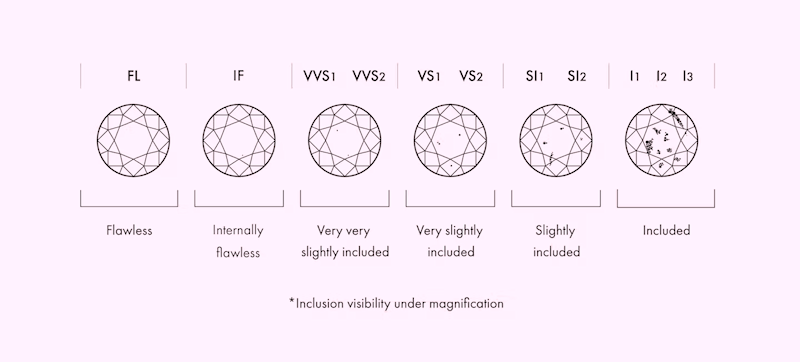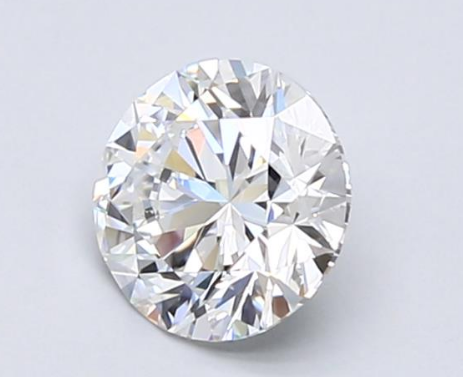
VVS1 Grading Clarity Information
VVS1 clarity is a classification of diamond clarity that indicates the highest level of purity and perfection within the very, very slightly included category. It is a highly sought-after grade for diamond buyers due to the exceptional quality and near-flawless appearance of the stone.
To understand VVS1 clarity, it is important to first understand the diamond grading system. Diamonds are graded by a combination of factors, including cut, color, and clarity. Clarity refers to the presence and visibility of inclusions, or flaws, within the diamond. Inclusions can be natural or man-made, and they can affect the appearance and value of the diamond.
The clarity grading system ranges from I3 (included) to FL (flawless), with several sub-categories within each grade. VVS1 clarity is a sub-category of the very slightly included (VVS) grade, which is one step up from the slightly included (SI) grade. It is the highest level of clarity within the VVS category, with VVS2 being the second-highest level.
Here is an example a diamond with VVS1 clarity:

VVS1 Diamonds Are Statistically Speaking Very Rare
The VVS1 clarity classification is reserved for diamonds that have very, very small inclusions that are extremely difficult to see even under 10x magnification. These inclusions are so small and well-hidden that they do not affect the overall appearance or brilliance of the diamond. In fact, VVS1 diamonds are considered to be nearly flawless, and they are highly prized for their exceptional quality and beauty.
To determine a diamond’s VVS1 clarity, gemologists use a combination of visual inspection and advanced magnification techniques. They carefully examine the diamond under 10x magnification, looking for any inclusions that may be present. If the inclusions are extremely small and difficult to see, the diamond is classified as VVS1.
Generally, They Are Very Beautiful Diamonds
The VVS1 clarity classification is an excellent choice for diamond buyers who want a high-quality, beautiful diamond that is as close to flawless as possible. These diamonds are exceptionally pure and have a stunning, radiant appearance that is sure to impress. They are also a great investment, as diamonds with high clarity grades tend to hold their value well over time.
5 Reasons To Consider VVS1 Clarity Diamonds
- VVS1 diamonds are high quality. VVS1 diamonds are considered to be of very high quality in terms of clarity. They have very few inclusions that are difficult for even a trained gemologist to see under 10x magnification. As a result, these diamonds have a high level of sparkle and brilliance.
- VVS1 diamonds are rare. Because VVS1 diamonds have such high clarity, they are less common than lower quality diamonds. This means that owning a VVS1 diamond can be seen as a status symbol, as it signifies that the owner has access to rare and high quality gemstones.
- VVS1 diamonds have a high resale value. Because they are considered to be of such high quality, VVS1 diamonds often have a high resale value. This means that if you purchase a VVS1 diamond, you can expect to get a good return on your investment if you decide to sell it in the future.
- VVS1 diamonds are durable. Inclusions and blemishes in diamonds can act as points of weakness, making the diamond more susceptible to chipping or breaking. Because VVS1 diamonds have very few inclusions, they are generally more durable and less likely to be damaged.
- VVS1 diamonds are aesthetically pleasing. Because they have such high clarity, VVS1 diamonds have a clean, pure appearance that is highly desirable to many people. This makes them pleasing to the eye and can enhance the overall beauty of a piece of jewelry.
7 Things To Keep In Mind When Buying VVS1 Clarity
- Consider the price. Because VVS1 diamonds are of high quality, they can be quite expensive. It is important to have a budget in mind and to compare prices from different vendors to ensure that you are getting the best value for your money.
- Look for certification. In order for a diamond to be considered VVS1, it must be certified by a reputable independent laboratory, such as the Gemological Institute of America (GIA) or the International Gemological Institute (IGI). It is important to look for this certification when purchasing a VVS1 diamond, as it provides assurance that the diamond has been thoroughly evaluated and meets high standards of clarity.
- Consider the cut. The cut of a diamond refers to its proportions and symmetry, which can affect the diamond’s sparkle and brilliance. VVS1 diamonds should have a well-cut, symmetrical shape to maximize their optical properties and create a stunning visual effect.
- Consider the setting. The setting of a diamond can also affect its appearance and overall value. A well-made setting can enhance the beauty of a VVS1 diamond, while a poorly made setting can detract from it. It is important to carefully consider the setting and choose one that will complement the diamond and enhance its overall beauty.
- Shop around. Because VVS1 diamonds are a significant investment, it is important to shop around and compare prices and options from different vendors. This will help you to make an informed decision and ensure that you are getting the best value for your money. Additionally, working with a reputable jeweler who has experience with VVS1 diamonds can provide valuable advice and guidance throughout the buying process.
- Consider the color. The color of a diamond can also affect its appearance and value. VVS1 diamonds are typically colorless, but they can also come in shades of yellow or brown. It is important to consider the color of the diamond and choose one that will complement the setting and your personal style.
- Consider the shape. The shape of a diamond can also impact its appearance and value. VVS1 diamonds are available in a variety of shapes, including round, princess, oval, pear, and marquise. It is important to consider the shape and choose one that will suit your personal style and the setting in which it will be placed.